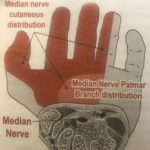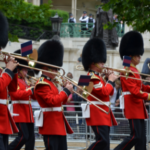
When we speak of shoulder instability, we are referring to the ball-in socket – the glenohumeral – joint of the shoulder. In shoulder instability, the head of the humerus is not maintained in the centre of the glenoid fossa. This can be due to a number of reasons.
Classification of shoulder instability
1. Degrees of shoulder instability
In apprehension, the patient merely fears a subluxation or dislocation.
In subluxation, there is a partial separation of the articular surfaces. A subluxation can be transient.
Meanwhile, dislocation involves a complete separation of the joint surfaces.
2. Types of glenohumeral instability
Anterior/inferior (ca. 80%)
Most of the time, the humeral head slides anterior and inferior relative to the glenoid fossa. The shoulder is most vulnerable when it is abducted and laterally rotated.
Posterior (ca. 10%)
In posterior instability, the humeral head slides the opposite way – posteriorly.
Multidirectional (ca. 10%)
If the glenohumeral joint is unstable in all vectors, there is multidirectional instability. This type of instability is usually congenital.
3. Grading
Similarly to knee or ankle instability, shoulder instability is graded into 1, 2 or 3. Although grading criteria may seem a bit arbitrary – and conditions are never this black and white – they are useful for clinicians.
- Grade 1: 25-50% translation, with the humeral head riding up on the glenoid labrum.
- Grade 2: 50-75% translation, with the humeral head riding up and over the glenoid labrum, before reducing.
- or Grade 3: >75% translation, with the humeral head remaining dislocated.
What causes glenohumeral instability?
Shoulder instability is either due to:
- laxity of the shoulder capsule and glenohumeral ligaments
- labral tears
- rotator cuff problems, e.g. biceps or supraspinatus tendinopathy, or muscle imbalances
- congenital joint anomalies (usually bilateral instability)
Therefore, shoulder instability often has the same causes as labral tears, or rotator cuff problems, i.e. trauma and overuse.
For example, a tackle with the shoulder in abduction and external rotation would be a direct trauma. While repeated overhead activities, such as boxing, swimming, racket sports or throwing are examples of overuse.
Generalized joint laxity or an anatomically different glenoid fossa (e.g. one that is shallower or tilted) are the main examples of joint anomalies. Osteopaths and other manual practitioners can test for generalized hypermobility by using the Beighton’s scale.
What are the symptoms of shoulder instability?
Because shoulder instability often comes hand in hand with labral tears, rotator cuff problems or other shoulder issues, symptoms overlap.
Generally, pain is worse with activity or certain arm positions. You may be aware of a history of catching or locking, or even prior dislocation.
Often, there is clunking or apprehension on external rotation with abduction.
Who gets shoulder instability?
If you have any injury to the rotator cuff or glenohumeral ligaments, you are at increased risk. Likewise, if you have been diagnosed with hypermobility syndrome, chances are your shoulders will be affected.
What treatments are there for shoulder instability?
If your shoulder is dislocated, you should have it reduced asap.
If you are suffering from acute pain, it is advised to protect, rest and ice the shoulder. You may also want to consider short-term use of an arm sling.
Shoulder strengthening
Anyone with instability is advised to strengthen their rotator cuff muscles. This can be done using a theraband. Because the ligaments are not fulfilling their task of providing stability, the muscles have to be toned to compensate.
Herbal medicine
A herbalist can advise herbs and supplements that reduce inflammation and support the connective tissue of the joint.
Acupuncture
An acupuncturist will focus on local shoulder points and channels/meridians associated with muscles that stabilize the shoulder.
Massage
Meanwhile, a massage therapist can work on muscles that have seized up as a result of instability. For example, massage will include trigger point release.
Can osteopathy help shoulder instability?
As an osteopath, I will treat any dysfunctions that I find. In practice, I look for muscle imbalances, reflex imbalances, and assess the nerve supply arising in the neck. I find strengthening of the rotator cuff very important.
For most patients, prognosis is very good. In severe cases, however, instability may lead to glenohumeral osteoarthritis or progress to a full dislocation.
The younger a patient is at dislocation, the likelier that it will re-occur. Recurrence rate is roughly 90% if the first dislocation was in teenage years, but only 15% after the age of 40.
So, if you have shoulder instability, you are likely to benefit from seeing an osteopath.
To book an Osteopathy appointment in New Malden or in Marylebone, phone 020 8942 3148 or contact Aston Clinic London.
Aston Clinic London is a third-generation complementary health clinic based in New Malden and serves the local areas of Kingston, Wimbledon, Raynes Park, Surbiton, Chessington, Worcester Park, Sutton and other areas of southwest London and Surrey.
Aston Clinic London also offers Osteopathy and Herbal Medicine in Marylebone, Central London.

